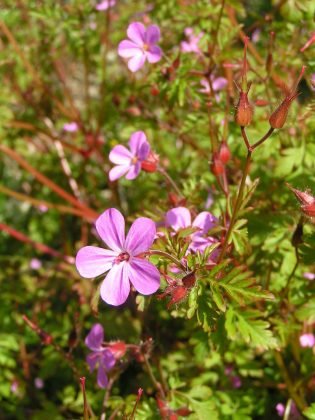By Rhiannon Allen
This column has covered weeds before, but I’d like to cover a particular one in detail. Each year, the Point Roberts Garden Club fields questions about this pest. This year, they received many inquiries about it.
The culprit goes by the local name of “Herb Robert.” It is a member of the geranium family,  Geranium robertianum, a low-growing groundcover that sports triangular, very deeply divided leaves that turn red under poor growing conditions such as drought, harsh sun or autumn weather. Its flower is rather pretty, with five tiny pinkish petals. The scent of its leaves is rank when crushed, which is how it acquired its other common name, “Stinking Bob.”
Geranium robertianum, a low-growing groundcover that sports triangular, very deeply divided leaves that turn red under poor growing conditions such as drought, harsh sun or autumn weather. Its flower is rather pretty, with five tiny pinkish petals. The scent of its leaves is rank when crushed, which is how it acquired its other common name, “Stinking Bob.”
While a dozen geraniums, including G. viscosissimum (sticky cranesbill) are native to our area and many species such as G. ‘Rozanne’ are sold as ornamentals, G. Robertianum is classified as a noxious weed in Whatcom County. While the common definition of a weed is just a plant in the wrong place, noxious weeds are undesirable for more than just aesthetic reasons. They are undesirable because they endanger people, agriculture or ecosystems. An example of the first is giant hogweed (Heracleum mantegazzianum), whose sap can cause severe chemical burns to skin. An example of the second is creeping buttercup (Ranunculus repens), which can kill livestock that ingest it.
Herb Robert belongs to the third category, taking over ecosystems and disturbing the delicate balance that characterizes a healthy, sustainable ecology. You can see its effects throughout Point Roberts. It blankets open shade roadsides and trails, having displaced same-sized native plants, such as starflower (Trientalis latifolia), which are attractive to early-season foraging bees, and nutritious Siberian lettuce (Claytonia sibrica, aka miner’s lettuce).
Nobody would eat Herb Robert because of the foul odor it emits in its defense. While it is not known to be toxic, and in fact was used as a medicinal herb in its native Eurasia, no herbivore would voluntarily eat this plant after smelling it. (Also, doctors and biochemists recommend not using this herb medicinally until its dosage, toxicity and benefits are better understood.)
So what is to be done with this noxious weed? Fortunately, it is easy to remove mechanically from home gardens. Although it has a fleshy tap root, it is much easier to pull up than other tap-rooted plants such as dandelion and dock.
Do this when the soil is moist and you will have relative success. If the soil is dry, you can either wait for autumn rain or irrigate the soil to the depth of a couple of inches before grasping the plant firmly at its base and giving it a slow pull. Put the plants in a black plastic garbage bag until they rot, after which they can be composted or put out for pick-up.
By the time you read this, dear readers, the plant will already have set its 2017 seeds, now scattered far and wide. So my best advice is to pull what you can now (or after the rains resume) to ease your 2018 labor. Then survey your garden late next spring to pull up the new and overlooked plants before they set their own seed.
To discourage the plant’s return via seeds venturing in from neighboring roadsides and gardens, mulch the cleared area to smother any remaining seeds and so that it will be easy to remove any new plants that begin growth. Another tactic is to plant a less noxious groundcover that will cover the area. Before you start looking for an appropriate ground cover, please take the time to do some research to learn about native groundcovers, noninvasive ornamental plants and noxious weeds. Good information can be found at co.whatcom.wa.us/914/Weeds and nwcb.wa.gov.
But what if you see a really widespread, serious infestation of Herb Robert? Well, frankly, if you are talking about places like roadsides, where it is ubiquitous in parts of Point Roberts, there’s really not much point in eradicating it. Even the Whatcom County Noxious Weed Control Board shrugs about removing it from these areas. Efforts are better put to keeping it out of home gardens and parkland.
If you are one of those landowners unlucky enough to possess a sea of Herb Robert, the best thing is to apply a very heavy mulch over the infestation and leave that in place for at least a year.
Note that while the Whatcom County Noxious Weed Control Board (bit.ly/2uydn16) maintains that glyphosate (Roundup®) can be applied to kill Herb Robert, it is difficult to recommend this control solution to home gardeners.
While the US Environmental Protection Agency registered glyphosate for use as an herbicide, recent studies have suggested that some marketed forms might cause cancer and birth defects.
In any case, chemical herbicides really should be used only as a last resort.
Comments
No comments on this item Please log in to comment by clicking here